The Concept of Balance in Slavic Mythology
I. Introduction
Slavic mythology is a captivating body of traditional beliefs, folklore, and myths that emerged from the Slavic people, an Indo-European ethnic group residing in Eastern Europe. At its core lies the concept of balance, a fundamental principle that permeates every aspect of their mythological worldview. Slavic mythology posits that the universe exists in a delicate equilibrium between opposing forces, an interplay that governs the natural world and human affairs alike. Understanding this concept of balance is essential to comprehending the intricate tapestry of beliefs and practices that constitute Slavic mythology.
II. The Slavic Worldview
The Slavic worldview envisions the cosmos as a vibrant and dynamic realm teeming with diverse deities, spirits, and mythical creatures. Each element within this cosmic system holds a unique purpose and plays a vital role in maintaining the delicate balance that sustains the world. The Slavic pantheon features numerous gods and goddesses who preside over various domains, such as thunder, fertility, and war. Alongside these deities, a multitude of spirits and mythical beings inhabit the natural world, influencing human fortunes and the workings of the universe.
III. The Duality of Nature
A prominent characteristic of Slavic mythology is the recognition of duality in nature. The Slavs believed that all things exist in pairs, each possessing a complementary and opposing force. Day and night, light and darkness, life and death—these are just a few examples of the dualities that pervade Slavic myths. This concept extends to the realm of the divine, where gods and goddesses often embody both benevolent and malevolent aspects, reflecting the complexity of the natural world.
VI. The Balance of Good and Evil
The Slavic understanding of balance extends to the realm of morality, where good and evil are not seen as absolute opposites but rather as complementary forces that coexist within the universe. Slavic myths often depict characters who embody both virtuous and malevolent qualities, reflecting the complexities of human nature. The concept of balance dictates that neither good nor evil can triumph indefinitely, as each requires the other to exist.
VII. The Balance of Life and Death
Life and death are fundamental aspects of the Slavic worldview, and their relationship is characterized by a delicate equilibrium. Slavic mythology recognizes that death is an inevitable part of life, and that it serves as a gateway to the afterlife. Rituals and ceremonies play a significant role in honoring the deceased and ensuring a harmonious transition between the worlds of the living and the dead.
VIII. The Balance of Order and Chaos
Order and chaos are two opposing forces that shape the Slavic cosmos. While order represents stability and structure, chaos embodies the untamed and unpredictable aspects of existence. Slavic myths depict a constant interplay between these forces, as order seeks to impose its structure upon the chaotic elements. The balance between order and chaos ensures that the universe remains dynamic and ever-changing.
IX. The Balance of the Human and the Divine
Slavic mythology emphasizes the interconnectedness between humans and the divine realm. Humans are seen as an integral part of the cosmic order, and they have the potential to influence the balance of forces through their actions and beliefs. Rituals, prayers, and offerings are believed to strengthen the bond between humans and the divine, fostering harmony and well-being.
X. The Legacy of Slavic Mythology
The concept of balance remains a fundamental principle in Slavic culture and tradition. The influence of Slavic mythology can be seen in art, literature, and folklore throughout Eastern Europe. Slavic mythology continues to inspire contemporary artists, writers, and musicians, who draw upon its rich tapestry of beliefs and symbols to explore themes of duality, harmony, and the human condition.
FAQ
Q: What is the central concept of Slavic mythology?
A: The concept of balance, which governs the interplay between opposing forces in the natural world and human affairs.
Q: How do good and evil coexist in Slavic mythology?
A: Slavic mythology views good and evil as complementary forces that exist within the universe, recognizing the complexity of human nature.
Q: What is the significance of rituals and ceremonies in Slavic mythology?
A: Rituals and ceremonies play a vital role in honoring the deceased, ensuring a harmonious transition between the worlds of the living and the dead, and strengthening the bond between humans and the divine realm.



